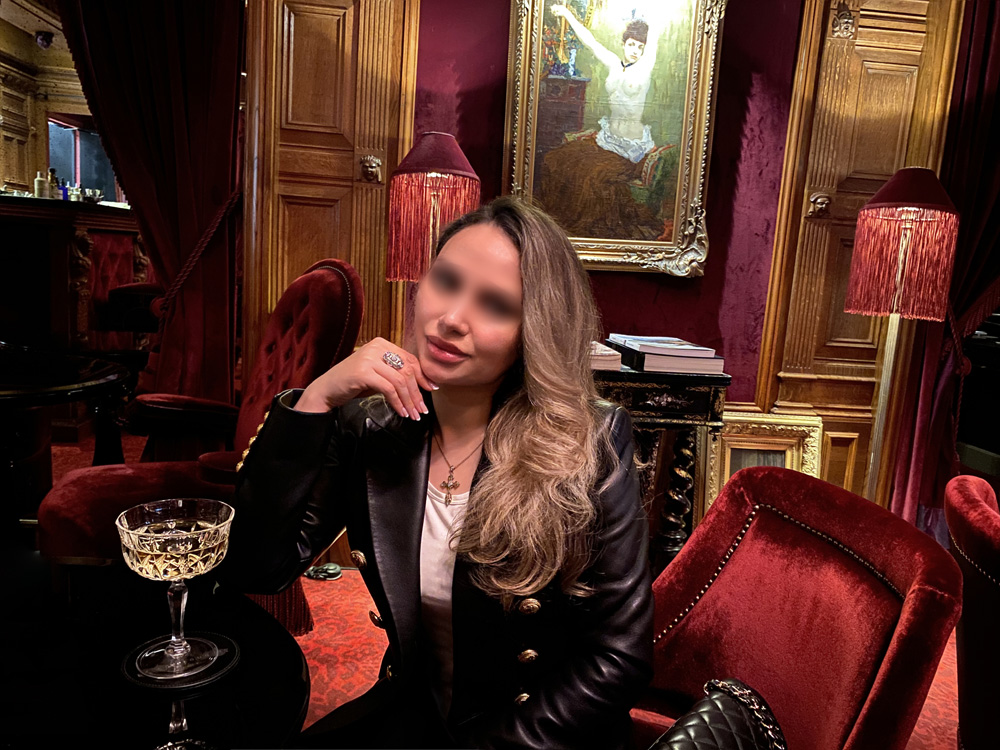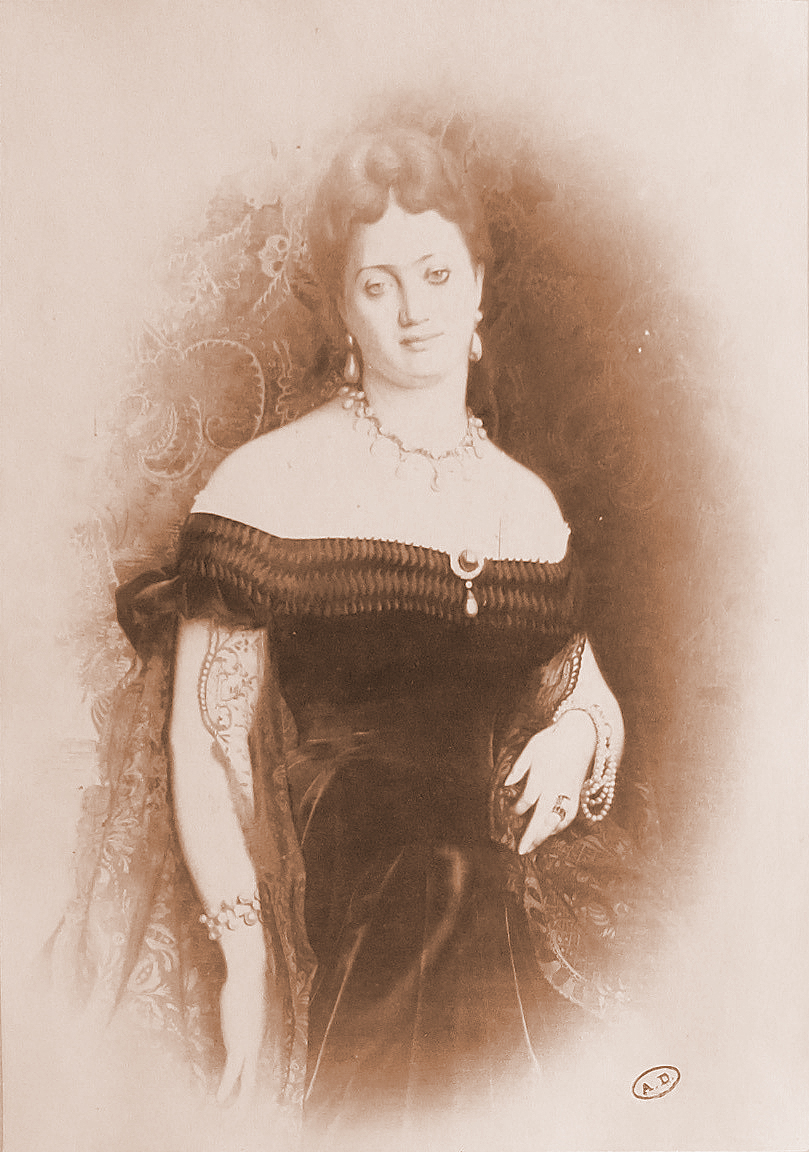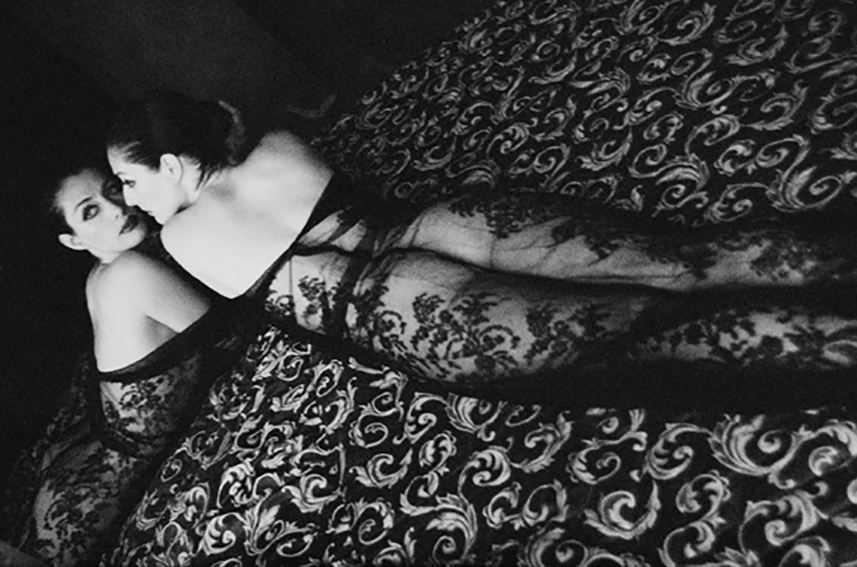Luxury Brothels of Paris 19th century
Reflections of Desire: Masculinity and Fantasy in the Fin-de-Siècle Luxury Brothel
“There are mirrors everywhere, on all the walls and all the ceilings; there are hangings everywhere; dazzling electric lights everywhere; and everywhere perfumes in this temple of Love.”1
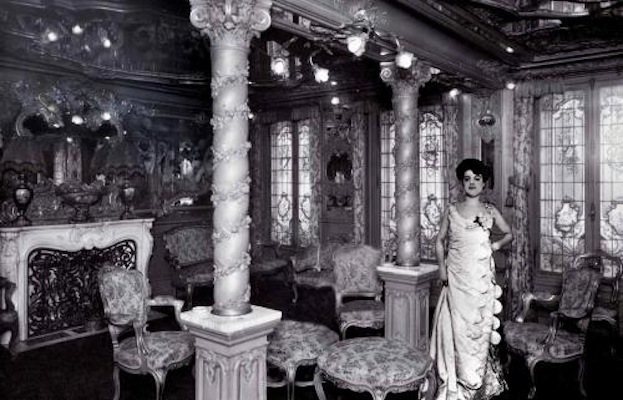
In the late nineteenth century, when new and spectacular forms of public entertainment began to flourish in Paris, a type of luxury brothel, or maison de luxe, evolved. Although houses of prostitution operating under police regulation had existed in the city for most of the nineteenth century, these extravagantly decorated brothels represented a departure from the modest, utilitarian spaces municipal authorities had envisioned as part of a strategy to sanitize prostitution. Located near the Opéra and the Bibliothèque Nationale, brothels such as Le Chabanais, Le Monthyon, and 6 Rue des Moulins were the exclusive domain of an elite bourgeois and aristocratic clientele. In their lavishly decorated interior spaces, men could fulfill erotic fantasies, satiate physical desires, and see everywhere reflected the outward signs of their own wealth and status.
A small promotional booklet produced for the Chabanais provides a compelling glimpse into this private world. Distributed at hotels in the heart of Paris, the pocket-sized pamphlet had a simple black cover and, inside, illustrations of different rooms in the brothel including a Turkish boudoir and an entry hall designed to resemble a grotto.2 The first of these images, L’Entrée (fig. 1), provides a representative example. By lingering on the details of the ornate sweeping staircase, tiled floors, and foliage-filled grotto, the artist emphasized the space itself, rather than the two small female figures who frame the scene.
The emphasis on the interior naturally raises questions. Why did the Chabanais advertise itself with pictures of its elegant rooms? How did these illustrations compare to the actual spaces themselves? What did these interiors, with their divergent decorative themes, truly represent? These are some of the questions that this essay pursues.
While historians have documented that fin-de-siècle Paris was characterized by an almost obsessive preoccupation with prostitution, few have commented on what I believe forms a distinct subcategory of this preoccupation: the nineteenth-century fascination with both representing and experiencing the representational world of the brothels.3 Scholars have noted the existence of luxury brothels, yet none have examined the photographic images or the broader issue of why the spaces were decorated in this manner.4
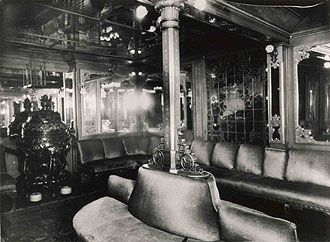
Fig. 2. Salon Chinois, ca. 1900. Chabanais Portfolio, Photograph. University of California, Riverside Special Collections Department.
This essay seeks to remedy this omission by examining fin-de-siècle photographs which document the interiors of several luxury brothels in Paris.5 Neither the original purposes of these photographs, nor their authors, are known. They are valuable documents, however, in that they reproduce views of the kinds of spaces so frequently depicted in literary and artistic representations of the period.6 An intact portfolio of photographs from one establishment, the Chabanais, provides an enlightening visual tour. A photograph of the Chinese salon (fig. 2) reveals a space filled with velvet sofas, an enormous Chinese urn, and walls framed with lacquered woodwork. In the Louis XV bedroom (fig. 3) copies of Boucher paintings surrounded by gold ornament frame each side of an elaborate, canopied bed. In the Moorish bedroom (fig. 4) intricately carved woodwork covers both the ceiling and the arched panels along the walls. Each space is a singular and self-contained representation of a distinct and exotic world.
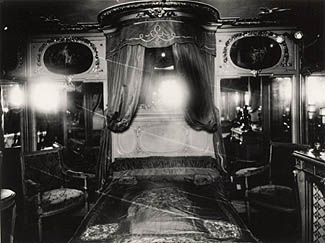
Fig.3. La Chambre Louis XV, ca. 1900. Chabanais Portfolio, Photograph. University of California, Riverside Special Collections Department.omething was perceived to be lacking in the arena of male sexual experience.7
The eclectic selection of rooms in the brothel suggests that beyond the mere acquisition of a particular product—here, the prostitute—male clients desired access to an entire set of fantasies. The interior of these bordellos, I argue, reflected the strategic deployment of resources to bring these desires to life. In this essay I intend to shed light both on the nature of these fantasies and the needs that informed their development. If the rooms reflected a common set of masculine desires, and if desire implies lack, it follows that
By tracing the historical and cultural iconography of eroticism that informed the development of these rooms, I will demonstrate that because of the particular nature of the nineteenth-century crisis in male sexual identity, the brothel deployed a set of fantasies that were rooted in the idea of “natural” sexuality. This concept of naturalness, in turn, was itself a fantasy rooted in Enlightenment philosophies of unrestrained sexuality and innate male power.
The brothel situated the fantasy of natural, unrestrained sexuality in two specific domains and artfully recreated them: the ancien régime world of sexual libertinism, and the sensual world of the Orient. To enact these fantasies, brothels employed not just thematically furnished rooms, with a multitude of authenticating details, but ultimately went beyond representation by staging multi-sensory erotic performances complete with costumes, music, fragrance, and female bodies.
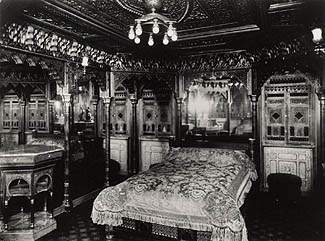
Fig. 4. La Chambre Mauresque, ca. 1900. Chabanais Portfolio,
I hold that what was at stake here was the desire to traverse the imagined boundaries of ordinary middle-class masculine sexual identity. In the private, theatrical space of the brothel, the client’s identity became fluid and mutable.8 The rooms of the brothel enabled the male client to unhinge himself from the pressures of modernity, from the restrictive bourgeois moral code, and from the limits of his own fixed persona, and to transform himself into something other. Divisions between reality and fantasy, normal and transgressive were seamlessly blurred.
“Signs of Masculine Suffering”
The fact that men in the late nineteenth century sought out an environment in the brothel where sexual experiences were staged and, to some extent, choreographed, suggests the possibility that male sexual identity was in a state of crisis. Indeed, Alain Corbin has commented that the very establishment and regulation of women in the brothel—not to mention the ideological confinement of “honest” women to the private sphere—was in itself a sign of “masculine suffering.”9 My own conclusion is that the nineteenth century’s obsessive preoccupation with fixing both the nature of the female body and its cultural locations ultimately and inadvertently brought the body of the bourgeois male to the attention of medical and scientific authorities. Under the scientific and psychological gaze of the era, this body proved to be undeniably problematic.
Historian Robert Nye has identified a recurring theme in nineteenth-century discourses surrounding medicine and psychology: a profound cultural anxiety about the sexual depletion and fragility of masculine bodies.10 These concerns arose, in part, because new understandings of male and female physiology and new theories about the biological effects of sexual intercourse emerged.
In the late eighteenth century, as historian Thomas Laqueur has demonstrated, a significant shift occurred in medical texts that radically altered the traditional understanding of male and female bodies.11 Since antiquity, scientists, anatomists and medical experts had believed that male and female reproductive physiologies were homologous variations of the same essential body.12 Beginning in the late eighteenth century, however, the vision of the sexes as homologous and hierarchical was displaced by a new medical view that emphasized their innate biological difference and incommensurability. Men and women were reinterpreted as two distinctly different creatures with entirely different reproductive organs.13
Sexual intercourse was also radically reinterpreted by medical authorities in light of this new biology of separateness.14 Theorizations emerged regarding the destabilizing effect of sexual acts on male and female bodies. Until the late eighteenth century, medical experts had defined sexual intercourse as an activity involving an active partner and a passive partner, and as a process of passing heat from the hotter (male) body to the cooler (female) one.15 Nineteenth-century understandings of the sexual exchange between men and women, by contrast, suggested that masculinity, as a finite resource, was in constant threat of depletion and de-stabilization through the sex act. Robert Nye notes that authorities viewed the transfer of semen during intercourse as a loss for man, but a gain for woman, “fortifying her sexual economy” and making her, ultimately, stronger and more masculine.16 In this logic, excessive sexual intercourse led to two anomalies: feminized men and masculinized women. Excessive sexuality, many experts argued, exhausted and depleted a man’s vitality, ultimately leaving him debilitated and impotent.17 Fueling these anxieties was the fact that France had the lowest birth-rate of any industrialized nation and it seemed to point to an alarming decline in the masculine instinct to reproduce.18
Finally, a new preoccupation with categorizing sexual perversions such as necrophilia, bestiality, masochism, and sadism reinforced the notion that a vast number of men were already in a state of decline. Psychiatrists tended to see extreme forms of aberrant behavior as expressions of underlying degenerative traits.19 Since an individual could not know if he had inherited underlying degenerative traits, the unspoken implication was that all men were potentially at risk of becoming abnormal. As Eugene Gley, author of an 1884 article on “Les Aberrations de l’instinct sexuel,” wrote, “Every man has, in effect, some weak point in his mind or body, and there is no such thing as an absolutely normal condition for the one or the other.”20
These collective concerns fueled widespread apprehension about the instability of masculinity. A desire to escape these various pressures, I argue, drove men to seek sexual refuge in the brothel. While nineteenth-century authorities on prostitution had asserted that an irrepressible, natural male sexual drive necessitated the existence of brothels, it is more likely that men, single or married, went there in part to escape these oppressive discourses of degeneration, emasculation, and impotence.21
The decision to seek out the brothel, however, was in itself a choice fraught with contradictory consequences and meanings. In the logic of the period, trips to the brothel invited the possibility of excessive sexual depletion and thus even more masculine degeneration. Furthermore, the very desire for deviant or theatrical types of sexual entertainment reflected, according to psychologists, the already depleted state of many men. In his 1891 study, Fetishism in Love, Alfred Binet discussed the fetishistic nature of all love, but in discussing particular fetishistic obsessions including “the Byzantine taste for luxury,” he identified a need “so frequent in our époque, to increase the causes of excitation and pleasure.” “Both history and physiology,” he continued, “teach us that these are the marks of enfeeblement and decline. The individual does not look for strong excitation with such hunger unless his power of reaction is already in a weakened state.”22
Fantasies of the Natural
If male customers at luxury brothels sought to allay these anxieties of modern masculine identity, which fantasies supplied psychic relief? Although an infinite number of transient private fantasies could have been staged within a brothel’s many bedrooms, collective fantasies, not individual ones, were reflected in the assortment of French, Orientalist and historical rooms.
In this section, I argue that French concerns with masculinity led to a collective desire for environments in which sexuality could be fantasized as natural and men as naturally powerful. Liberated from the constrictions of bourgeois morality and the scientific, psychologizing gaze of modernity, male virility would have been, in this idealized natural realm, an uncontested, infinite resource and feminine receptivity would have been inspired by more than simply monetary concerns.
Although the fin-de-siècle luxury brothel was a uniquely modern place, the vision of naturalness that it commodified for its clientele grew out of fantasies that had circulated in European culture since the eighteenth century. Following a period of European history characterized by social conservatism and puritanical religious beliefs, the eighteenth century represented, in the words of historian Edward Shorter, a “release of the libido.”23 Philosophers of the period reframed sexuality as pleasurable and positive, and celebrated the naturalness of bodily urges.24 Enlightenment philosophies of hedonism, promoted by philosophers such as Diderot, combined with new philosophies of utilitarianism in advancing this novel view of sexuality.25
Eighteenth-century European philosophers took a renewed interest in primitive societies which not only fueled erotic fantasies about other cultures, but also provided a mirror in which Europeans could contemplate their own sexual lives. The French exploration of Tahiti, and the published accounts that followed, for example, exposed Europeans to a society with a comparatively more innocent and natural approach to sexuality.26 It suggested to many philosophers that the religious and cultural prohibitions controlling European sexual life were arbitrary impositions that restrained men from expressing their natural, and therefore moral, sexuality. Fascination with primitive peoples inspired the utopian idea of the noble savage, upon which Enlightenment philosophers imaginatively projected fantasies of a European sexuality unleashed from society’s restraints.27 Although Europe had always had an interest in foreign and exotic cultures, a new fascination with the sexual lives of other cultures was born in the eighteenth century.
This strong new sexual current in eighteenth-century European philosophy quickly disseminated throughout society and laid the groundwork for fantasized ideals of absolute sexual freedom. As the population became more literate and printing technologies improved, radical and subversive ideas became easily available to a middle class populace in the form of newspapers, pamphlets and books.28 In the post-Enlightenment era these ideals collided with a new era of mass consumption, and were codified into a set of popular fantasies: the fantasy of the eighteenth-century libertine who mastered the arts of seduction and erotic expression, and the fantasy of the intrepid European imperialist, exploring the limitless sensual possibilities of the Orient. They found their ultimate expression in the late nineteenth-century dream of aristocratic and “Oriental” sexualities so prevalent in the maisons de luxe.
Aristocratic Fantasy
The first fantasy that the brothel sought to conjure up was the privileged ancien régime world of licentious sexuality. Since the bourgeoisie, even in the late nineteenth century, were still enamored with the aristocratic way of life, it is not surprising that this fantasy would be omnipresent in luxury brothels.
Among the upper classes in Europe, the Enlightenment liberalization of attitudes towards sexuality gave birth to libertinism, in which the pursuit of sexual pleasure was taken to an extreme.29 Sexual promiscuity and adultery became fashionable among the aristocracy throughout Europe and led to a rich body of literature that celebrated seduction.30 Among aristocratic circles in France, masquerades, balls, and private clubs supported an environment of exploration and sexual license.31 Both the libertine lifestyle and its literature rejected the religious and societal notion that sex should be focused on procreation, and instead promoted the exploration of various forms of deviant sexuality including voyeurism, flagellation, and bondage.32 Yet, even the most famous proponent of the libertine life, the Marquis de Sade, defended his perverse passions by describing his urges as “natural” and, by implication, normal. “I am guilty of nothing more,” Sade asserted, “than simple libertinage such as it is practiced by all men more or less according to their natural temperaments or tendencies.”33
Although these philosophies of libertinism circulated primarily in aristocratic circles, they eventually permeated popular culture as well. The early nineteenth century saw the proliferation of erotic literature, pornography, and lithographic imagery that circulated extensively among the male population.34 These print media made the aristocratic fantasy of sexual libertinism, if not the actual practice of it, available to men of all classes.
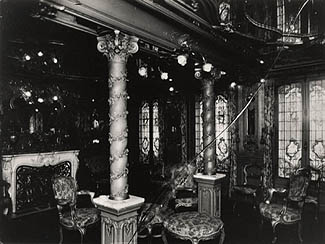
Fig. 5. Salon, ca. 1900. Chabanais Portfolio, Photograph. University of California, Riverside Special Collections Department.
Luxury brothels in the late nineteenth century deliberately sought to conjure up this erotic world of aristocratic privilege. In many maisons de luxe, walls were decorated with lithographic prints which called these fantasies to mind.35 Erotic torture chambers, equipped with all the required implements, were standard in many luxury brothels.36 Even the generally aristocratic manner of furnishing the top brothels with rooms decorated in various ancien régime styles reinforced the strong association between upper class wealth and sexual extravagance. The eclectic rococo-inspired Salon at the Chabanais (fig. 5) and the Chambre Louis XV (fig. 3), for example, provide evidence of this trend as the rooms utilized gilded chairs, carved mantelpieces, stained glass, and mirrors typically associated with aristocratic décor.
In the late nineteenth-century popular imagination, particular styles of furniture were strongly associated with the monarch under whom they had evolved. This was reflected not only in the gendered interpretation of past regimes but also in the broader tendency, predating the nineteenth century, to see aristocratic styles as anthropomorphic extensions of the king’s body itself.37 Leora Auslander describes the ritualistic treatment of the king’s possessions under Louis XIV: a particular form of fetishism characterized the apogee of absolutism. The very mundane objects used to assist the king in the satisfaction of his bodily needs were encased in gold and granted the same gestures of respect as the king’s body itself.38
The fetishistic attitude towards these inanimate things had to do with the notion that everything connected with the king retained his power. “The king’s objects,” Auslander comments, “were the king, and consequently the style of these objects belonged to the king.”39
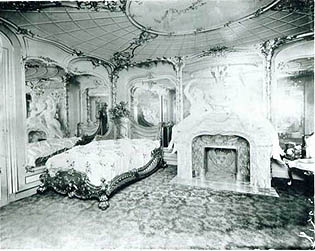
Fig. 6. Chambre de Lords at Le Monthyon, ca. 1900. Photograph. Paris, Bibliothèque Nationale de France.
This strong psychological association between particular styles and monarchs continued into the nineteenth century. Louis XV possessed a notorious reputation for seduction and promiscuity and it doubtless colored the nineteenth-century perception of his styles.40 Descriptions of the style tended to anthropomorphize it, conflating the objects that represented the Louis XV style with his mistresses.41 In Joris-Karl Huysmans’s 1884 novel A Rebours, the character Des Esseintes ardently describes the seductive charms of Louis-Quinze furnishings, characterizing the eighteenth century as, the only age which has known how to envelop woman in a wholly depraved atmosphere, shaping its furniture on the model of her charms, imitating her passionate contortions and spasmodic convulsions in the curves and convolutions of wood and copper.42
Des Esseintes’ fantasy of an eighteenth-century aesthetic that shapes furniture on the model of female charms finds a clear parallel in the Monthyon’s rococo-inspired Chambre de Lords (fig. 6), a room in which life-sized nude female sculptures appear to spring from the mantel. The eroticism associated with eighteenth-century furnishings, however, was not always so literal. In a later passage in A Rebours, Des Esseintes fondly recalls a white lacquered bed in Louis XV style that contributed to his seductions by adding “titillation, that final touch of depravity so precious to the experienced voluptuary,” who would be excited, he continues, “by the pretended purity of a bed of vice apparently designed for innocent children and young virgins.”43
By means of eighteenth-century aristocratic décor, torture chambers outfitted with harnesses and whips, and albums of erotic prints, late nineteenth-century maisons de luxe deliberately sought to invoke the dream of upper-class libertine excess.44 These various trappings, commentator Louis Fiaux noted in 1896, allowed “old men and exhausted libertines” to see brought to life “the obscene ghosts of their imaginations.”45
The regulation of brothels in the nineteenth century had acknowledged a natural male need for sexual release, but this need had been institutionalized, medicalized, and stripped of the elements of play, sensual exploration and perversity which had been at the heart of the libertine experience. The later nineteenth-century taste for luxury brothels, however, and their intentional mimicry of aristocratic spaces, both real and literary, reflected a masculine desire to retrieve and relive this lost period of European sexual frivolity and aristocratic male potency.
The Eroticized Orient
The other dominant brothel fantasy, similarly rooted in Enlightenment ideas of natural sexuality, was that of visiting the erotic terrain of the Orient. A typical luxury brothel offered clients rooms decorated in Turkish, Egyptian, Chinese, Japanese, Persian and Moorish styles.46 These spaces, Fiaux observed, enabled the French client to experience the illusions of affairs in foreign lands and, for the foreign visitor, the chance to imaginatively return to an “absent homeland.”47 While it is unlikely that the visitors were actually from these foreign locations, the settings are all representative of countries that were subject to various European imperialist projects and likely flattered the mostly European clientele by reminding them of their role as powerful conquerors of foreign and exotic lands. Fiaux noted that the array of Orientalist rooms in many brothels was not surprising since these spaces were, after all, “so well adapted for sexual practices.”48
How was it that Orientalist rooms came to be understood as well-adapted for sexual practices? In the vision of Europe, the Orient was a sexual pleasure garden, a “dreamworld of heightened sensuality.”49 More generally understood in this context as a land of exotic otherness, rather than a specific country or people, representations of the Orient were replete with sexual metaphors of seduction, voluptuousness, temptation, and domination.50
The preoccupation with sexuality and the East is clear in the enormous body of French Orientalist art and literature. The sexuality that was either suppressed or highly regulated in the European world was often imaginatively projected onto fictional accounts of other cultures.51 Edward Said sees a direct connection between the increasing complications of European sexual life and the growing fantasy of a licentious, eroticized Orient.
He writes: for nineteenth century Europe, with its increasing embourgeoisement, sex in society entailed a web of legal, moral, even political and economic obligations of a detailed and certainly encumbering sort…the Orient was a place where one could look for sexual experience unobtainable in Europe…In time “Oriental sex” was as standard a commodity as any other available in the mass culture, with the result that readers and writers could have it if they wished without necessarily going to the Orient.52
Roland Barthes sees this relationship as well in his analysis of the part autobiographical, part fictive travel writings of French writer Pierre Loti. He sees Loti’s character in the 1879 novel Aziyadé as “sinking deliciously into Asiatic debauchery” to evade “the moral institutions of his country, of his culture, of his civilization.”53 For Loti’s characters, Barthes notes, specific location, be it Turkey or the Maghreb, is somewhat irrelevant. What is important is the Orient’s function as “merely a square on the board, the emphatic term of an alternative: the Occident or something else.”54
The late nineteenth century saw the widespread use of exotic architectural styles in the construction of European theaters, dance-halls, expositions and various spaces of popular entertainment. The Oriental space, as it was understood in nineteenth-century Europe, was imprinted with associations of leisure and pleasure, and eventually became a commodity experience in itself. What literary critics such as Said and Barthes have discerned is the concurrent construction and commodification of another kind of Oriental space—this one strongly saturated in associations with sexuality and escape—that existed not in any material reality but within the literary imagination alone.
If we peel back the layers of this European fantasy of the Orient, so pervasive in nineteenth-century culture, it soon reveals itself to be one specifically focused on the seduction of exotic women and the imagined absence or impotence of exotic men. The ultimate symbol of this scenario was the harem, which Malek Alloula identifies as the undisputed locus of sensual pleasure and perversion in the European imagination.55 Although harems were most often associated with Turkey, Egypt, and North Africa, I would argue that the harem colored the idea of all “exotic” women without differentiating between various countries or cultures. Thus, the underlying fantasy embedded in the symbol of the harem—a dream of passive, receptive, trapped femininity—would have been invoked as easily in a Japanese boudoir, as in a Moorish one.56
Joan Del Plato, who has analyzed the extensive use of the harem motif in European art, concludes that although nineteenth-century opinions of the harem were varied, apologists viewed the harem as “a return to a truer form of society.”57 For these proponents, Del Plato argues, the idealized harem: proffered a simple model of natural social harmony viewed from the perspective of an increasingly complex and mechanized industrial society…Each sex seemed to know its place and acted accordingly, the man dominant and even cruel, if necessary, the woman, always receptive and resigned.58
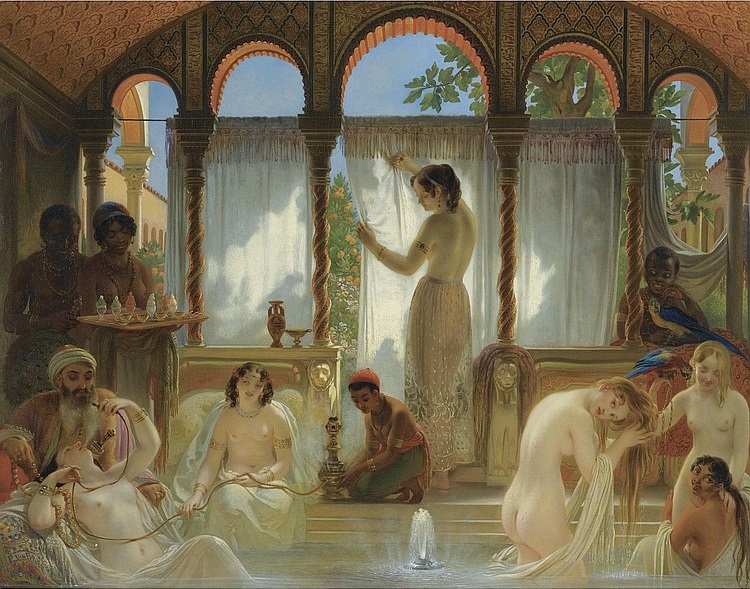
Le bain au Harem (c. 1830), Philippe-Jacques van Bree – a typical European Orientalist harem scene.
Beyond the generalized eroticization of the East, the harem focused, reproduced, and provided a specific fantasized location for the bourgeois man’s escape from the responsibilities and limitations of marital life. There, Del Plato posits, he could imaginatively fulfill his latent desire for sex with multiple, accommodating female partners.59
The absence of the male in the imaginary harem replicates the frequent exclusion of the male in artistic representations of the harem and produces the same effect: securing the voyeuristic position of the implied male spectator.60 Embodied in the sensual Orientalist paintings of, the viewer of this type of scene is being given the illusion of possessing a certain gaze, implying a penetration of this forbidden space, and the painting becomes the simulacrum through which this level of power can be attained.61 The décor of the Chabanais and similar brothels, I argue, brought this fantasized penetration of space into a fully three-dimensional reality.
Because this fantasy was more about submissive and sexualized female bodies, and masculine mastery of them, than actual Oriental ones, it was easily expanded to include women of European descent. This explains, in part, why the harem concubines in so many European Orientalist paintings appear to be white, and non-white slaves were often incorporated into the imagery to underscore this racial contrast.62 Ivan Kalmar identifies this pictorial strategy in harem painting as “a perverse projection of the Western woman into the subject position of a powerless sex slave.”63 The mutability of the subject position in the harem fantasy, which seems to primarily rely on staging the naked female body in an environment that suggests the Orient, is one of the reasons why it was so easily recreated for consumption in the brothel.
Finally, one must note that the exotic harem motif in the luxury brothels likely functioned in tandem with the client’s awareness that the brothel was, in a sense, the Frenchman’s harem—an enclosed place of submissive, sexually available females. While readily consuming the fantasy of the Oriental harem, French men may have also been aware that the reality of the European system of regulated prostitution directly mirrored the same power dynamics of the harem.64 The European attitude toward the harem was complex. On the one hand, the harems of Muslim societies, and the Muslim men who ruled them, were frequently criticized by ethnographers and political analysts in Britain and France as backward and evil.65 On the other hand, the noble mission of rescuing the native woman from her own kind was, Gayatri Spivak has pointed out, a particularly seductive part of the imperialist fantasy.66 The brothel may have provided an ideal setting for bringing this fantasy to life.
By placing the actual French brothel-as-harem in a fantasized Orientalist context, psychological distance was achieved and these dynamics were imaginatively re-framed as natural and “other.” Indeed this fantasy, within the brothel, had to be displaced onto the Orient. The East, after all, was barbaric and the West civilized. Any explicit suggestion of a similarity, within brothels, would have ruptured the fantasy by exposing Westerners to their own barbarism. Thus the Eastern harem and the French harem merged into a mythologized fantasy of the harem in the Parisian brothel. The appeal of the mythologized harem, Del Plato points out, in her analysis of the harem as a “rich, unfixed symbol” in European culture, is that its inhabitants represented a “truer, more fundamental natural womanhood than their western counterparts.”67
Whether appropriating the power of the monarch or the power of the imperialist conqueror, both fantasies in the brothel helped men constitute a more masterful sexual identity. If we can say that normal nineteenth-century sexual activity took place in the sober institution of marriage, or the clinical environment of the regulated brothels, under the imagined surveillance of political, medical and cultural authorities, the fantasy life of sexuality continued to imaginatively occupy these other domains, culturally coded as safe havens for sexuality both natural and perverse.
Beyond Representation—Stepping Into the Scene of the Fantasy
Luxury brothels commodified these fantasies and brought them into material reality. This materialization reflected the client’s desire to not just look at, read, or imagine the fantasy but, rather, to step bodily into the very fabric of the fantasy itself.
In this section, the brothel went beyond representation of these erotic fantasies, providing instead a multi-dimensional and multi-sensory re-enactment of these other worlds. With the strategic usage of female bodies, music, scents, and costumes, the brothel owners fulfilled a desire for total immersion in the illusion.
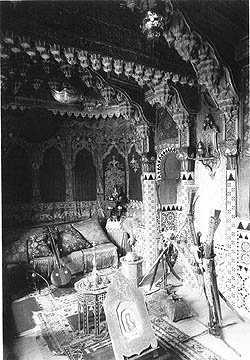
Fig. 7. Le Salon turc de Pierre Loti. Photograph. Reproduced in Europe Exotique.
A nineteenth-century urge to translate literary and artistic spaces into real spaces, and to use these spaces, in turn, as vehicles for private fantasy, was clearly evident in the homes of Orientalist writers such as Alexandre Dumas and Pierre Loti, and painters such as Charles Cournault and Victor Madeleine.68 Inspired by trips abroad, these artists and writers returned home to both represent the Oriental experience in their work, and imaginatively recreate Oriental spaces in their homes. Loti decorated his home in Rochefort-sur-Mer in a manner that was uncannily similar to the brothels with an assortment of thematic, exotic rooms. Loti was well known for his extensive body of fiction inspired by his travels; after each of his own trips to foreign countries, he created Turkish, Arab, Chinese, and Japanese rooms in his family home.69 Le Salon Turc (fig. 7), for example, was a space filled with elaborate tiles, arched passageways and intricate woodwork, as well as pipes, embroidered pillows, and pictures from his travels.
Loti’s creation of rooms in foreign styles expressed his desire to contain memories and erotic fantasies that were linked to his real experiences abroad.70 The creation of rooms that conjured up the memories of places that he had actually visited, and fictional episodes that he had written about, suggests the extent to which fantasy and reality were viewed by Loti as being fluid and interchangeable. Fueled by an “eternal nostalgia” he wrote in his journal on May 22, 1894, “for where I am not,” his desire to recreate foreign spaces that he had visited eventually expanded to include a desire for historical periods he had never experienced.71 Thus, Loti eventually constructed Gothic, Medieval, and Renaissance rooms in his home, alongside the Orientalist rooms.72
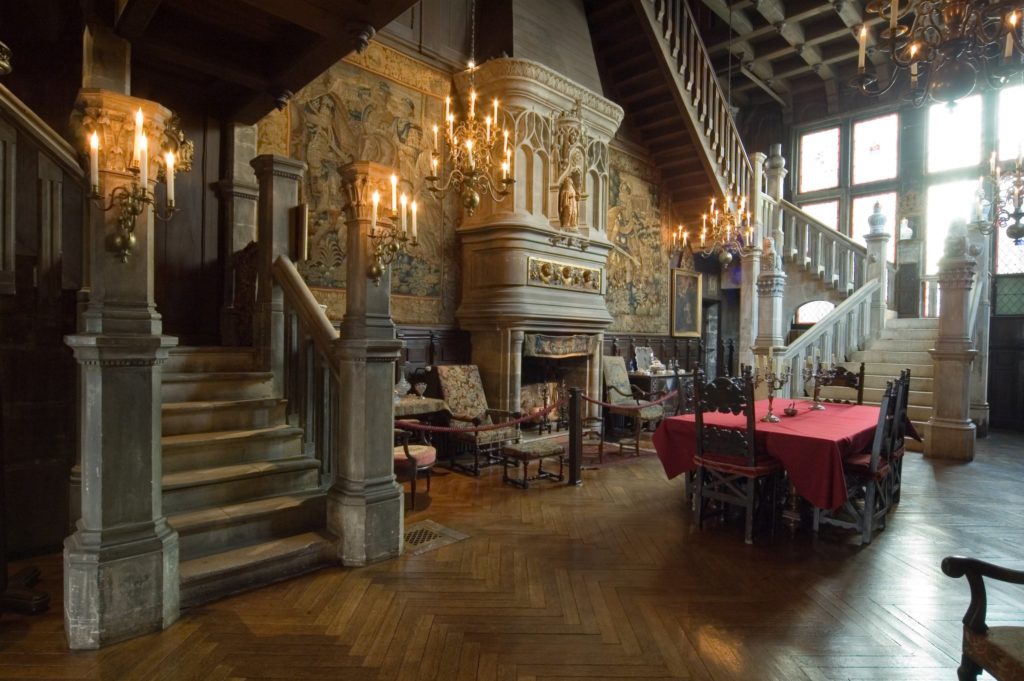
These fantastic spaces in Loti’s house at Rochefort-sur-Mer literally became part of a staged backdrop before which he could play at certain identities. He had himself photographed in the rooms, wearing exotic or historic costumes that matched each décor.73 Not satisfied to keep this experience private, he threw elaborate costume dinners that celebrated the inauguration of each thematic room in his home. Every detail from the food served, to the music played, to the costumes of the guests, brought to life the desired place or period. Writing about his April 12, 1888 dinner to celebrate the debut of his Salle Gothique, he blissfully recalls, “for two fugitive moments, I had the complete impression of the middle ages…”74
This elaborate playacting was not necessarily without precedent in France. In the eighteenth century Marie Antoinette, fueled by a desire to create a simple, pastoral refuge for herself, ordered the construction of a little hamlet, Le Hameau, near the Petit Trianon at Versailles. In this compact but life-sized village, replete with farm animals, ponds, haylofts, and cabbage patches, she dressed as a shepherdess and played, for pleasure, at being something other than an aristocrat.75
While Marie Antoinette’s hamlet could be seen as mere aristocratic eccentricity, the home of Pierre Loti, an upper-class man in the late nineteenth century, provided a different context for this stylized play-acting. Loti’s home, like the luxury brothels, reflected a desire to be elsewhere that signified more than a sentimental longing for country life. It represented, instead, a complex, eclectic and characteristically modern desire to be anywhere other than “here.”76
Historian Stephen Bann sees in Loti’s elaborate stage-setting a longing, distinctive to the nineteenth century, to pass beyond representations and fully experience “the otherness of the past.”77 This desire for history, Bann writes, was informed by the same conditions that drive all acts of representation, the “need to exteriorize in a particular medium images and fantasies to which the subject declares a relationship of desire and lack.”78 Representations of other worlds in literature and in art were not enough to effect his own transformation, which was, perhaps, the real goal of these efforts. It was critical that he bring his body into the scene of the fantasy. Thomas Albrecht concludes that these scenes allowed for a total, if transient, shift in identity for Loti. Loti, Albrecht argues, could avoid feeling restricted to a single persona. He could, for fugitive moments, “be something more than just a nineteenth-century, middle-class French man.”79
Luxury brothels similarly strove to erase the signs of modernity, and transfer the client to another world: whether it was an eroticized re-imaging of France’s past, or a sensual environment in the Orient. In the best aristocratic brothels, a complete assortment of women of different nationalities was made available to match with the appropriate rooms. A late nineteenth-century writer described a top maison de luxe as featuring, “a Negress, a Mexican, a Chinese, a German, a Greek, an Algerian, one or two English, a Spaniard, an Italian, and two, three, or four Frenchwomen from various areas.”80 Each one, he noted, wore her national costume, and each one attended to the room decorated in the style of her country.81
In addition to matching women with rooms and costumes which corresponded to their ethnic or national backgrounds, a general environment of theatricality prevailed in the brothels. Brassaï commented that even the appropriate music was used to complement the experience of specific rooms in the Chabanais.82 The elaborate staging of each boudoir, the matching of ethnic personnel with their appropriately designed room, the use of costumes, music—this multiplicity of details served to authenticate the historical and exotic scenes. Alain Corbin describes a kind of theatrical play-acting that expanded to include other fantasies of “nymphs awaiting] their clients in Calypso’s grotto, while well-rehearsed “nuns” received theirs in Sadian convents.”83
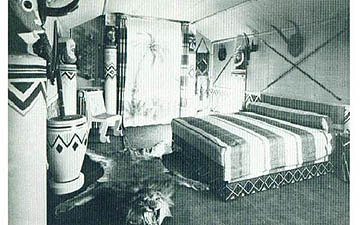 fig 8: Image of African Room
fig 8: Image of African Room
Fig. 8. Image of African Room in the One Two Two. Date Unknown. Exhibition sur les Maisons Closes. Photograph taken by author at Musee de l’Erotisme, Paris, August 2005
In the early part of the twentieth century, the fantasies provided by the brothel became increasingly eclectic and varied. The possibility of imaginative erotic journeys expanded to include even more possibilities beyond the conventional tropes of European Orientalist or aristocratic fantasy. One brothel included an Eskimo igloo, and another an African room featuring a savage hut decorated with masks, animal skins, and the head of a rhinoceros (fig. 8).84
Eventually the mechanisms of modern travel became inspirations for erotic fantasy.85 One brothel had a room designed to mimic the compartment of a railroad car. The room was designed to provide the complete illusion of travel as panoramic scenery slowly passed by outside of a false window. At another establishment, a room was famously decorated to replicate the cabin of a transatlantic ship (fig. 9).86 In this bedroom, an elaborate pulley system caused the bed to rock as if it were at sea.87 It recalls a similar room described by Huysmans in A Rebours. Des Esseintes constructs a dining room designed to mimic a ship’s cabin which allows him to enjoy,all the sensations of a long sea-voyage, without ever leaving home; the pleasure of moving from place to place, a pleasure which in fact exists only in recollection of the past and hardly ever in experience of the present…the imagination could provide a more-than-adequate substitute for the vulgar reality of actual experience.88
Huysmans’s decoration of spaces in his literary work, Loti’s decoration of his family home, and the luxury brothel’s elaborate décor and staging of erotic fantasies all seem to reflect a nineteenth-century idea that the simulation of an experience could be as satisfying, if not more so, than the real experience itself.
Conclusions
In peering through the keyhole of the maisons de luxe, it is clear that, far from being a marginal phenomenon, the fin-de-siècle luxury brothel was at the center of a number of issues critical to our understanding of gender, sexuality and commodity culture in late nineteenth-century Paris. As representational spaces, brothels functioned as hermetically-sealed dream worlds in which the objects in the interior became vehicles for visual fantasies.
In an era when male sexuality was perceived to be fragile and unstable, brothels provided a fantasized recreation of ‘natural’ sexual worlds where men could imaginatively reclaim their virility and mastery. Calling on the dreams of aristocratic libertine sexuality and Oriental eroticism so prevalent in nineteenth-century French culture, brothels enabled fantasies that had long circulated in art, literature, and the popular imagination to come to life. To effect this transformation, they went beyond architectural representation, utilizing costumes, music, and prostitutes’ bodies to create a complete multi-sensory experience.
Brothels such as the Chabanais and the Monthyon, then, attempted to satisfy this desire, so prevalent in late nineteenth-century culture, to be “elsewhere.” As in Pierre Loti’s home, the brothel décor soothed a crisis in conscience, imaginatively setting the stage for fluid masculine identities, and allowed the client the opportunity not only to be somewhere else, but to become something other than a middle-class French man. And it did so within the reassuringly safe and familiar confines of a Parisian hôtel particulier.
I would like to thank Professor Pat Morton, Professor Steven Ostrow, and Professor Gabriel Weisberg along with the anonymous reviewer at Nineteenth-Century Art Worldwide, Petra ten-Doesschate Chu, and Robert Alvin Adler for their helpful suggestions.
Article by Gina Greene.
Discover about the range of my luxury escort experiences in Bristol
Yours, Cassandra
